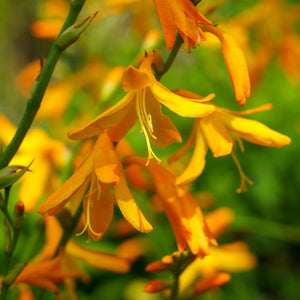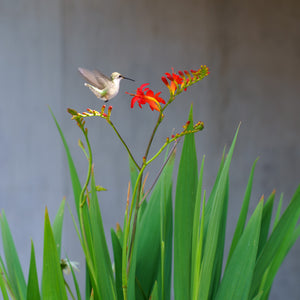The Crocosmia Guide
Crocosmia, with its fiery blooms and graceful arching stems, brings a touch of vibrant color and dynamic movement to any garden landscape. Known for their striking flowers and lush foliage, Crocosmia plants are perfect for adding height and drama to borders, garden beds, and containers. These plants are admired for their ability to thrive in a variety of conditions and their relatively easy care. Whether you're aiming to enhance your garden's visual appeal, create a lively display, or add a unique element to your space, Crocosmia offers a captivating and versatile solution. Explore our Crocosmia Guide to learn more about cultivating and caring for these stunning plants, and discover how to incorporate them into your garden for lasting beauty and enjoyment.
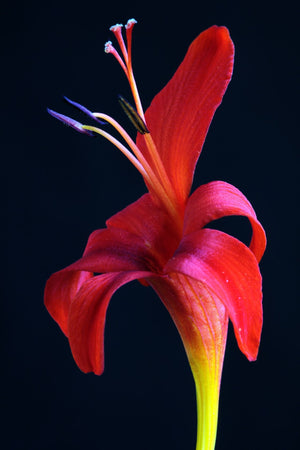
About Crocosmia
Crocosmia is a genus of flowering plants in the Iridaceae family, comprising about seven species. These plants are native to the grasslands of southern and eastern Africa, including South Africa, Tanzania, and Malawi. The name "Crocosmia" is derived from the Greek words "krokos" (saffron) and "osme" (smell), referring to the saffron-like scent produced when the dried flowers are immersed in water.
Crocosmia plants are known for their bright, tubular flowers that come in shades of red, orange, and yellow. The flowers are borne on arching stems and bloom from mid-summer to early fall, providing long-lasting color in the garden. The foliage is typically sword-shaped and a vibrant green, forming dense clumps that add texture and interest even when the plants are not in bloom.
Some popular species and varieties of Crocosmia include Crocosmia x crocosmiiflora (a hybrid species known for its vigorous growth and prolific blooms), Crocosmia 'Lucifer' with its vivid red flowers, and Crocosmia 'Emily McKenzie' known for its striking orange flowers with red centers. Each species and variety has its unique characteristics, but all share the common traits of vibrant flowers and easy care.
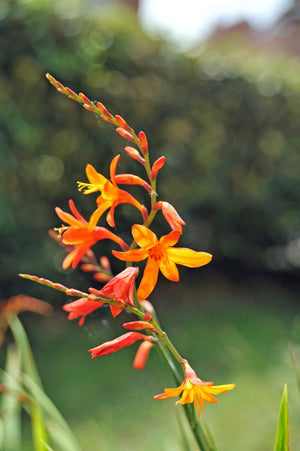
Planting Crocosmia
Crocosmia plants require specific planting conditions to ensure their successful establishment and flourishing growth. Here are some essential guidelines for planting and caring for Crocosmia:
Soil: Crocosmia prefers well-draining soil that is rich in organic matter. A loamy or sandy soil works best. Ensure the planting site is free from heavy clay or waterlogged conditions, which can cause the corms to rot. Adding compost or well-rotted manure can improve soil fertility and drainage.
Light: Crocosmia thrives in full sun to partial shade. Choose a location with at least six hours of direct sunlight per day for optimal blooming. In hotter climates, some afternoon shade can help protect the plants from intense heat.
Watering: Crocosmia requires regular watering to keep the soil consistently moist but not waterlogged. Water the plants deeply, allowing the top inch of soil to dry out between waterings. During hot, dry periods, increase the frequency of watering to maintain soil moisture.
Planting Depth: Plant Crocosmia corms about 3-4 inches deep and 6-8 inches apart to allow for proper air circulation and growth. When planting in the ground, dig a hole twice as wide and the same depth as the corm to encourage root spread.
Mulching: Apply a layer of organic mulch, such as compost or shredded leaves, around the base of the plants to retain moisture, suppress weeds, and regulate soil temperature. Avoid covering the crowns directly, as this can lead to rot.
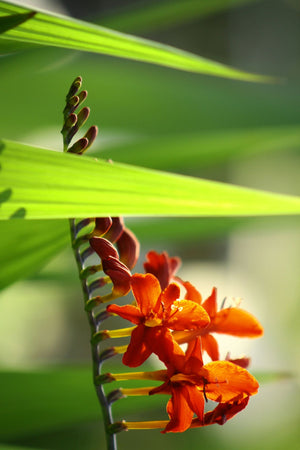
Care for Crocosmia
Crocosmia plants require specific care to ensure their optimal growth and health. Here are some general guidelines for the care of Crocosmia:
Watering: Keep the soil consistently moist during the growing season but avoid waterlogging. Water the plants deeply, allowing the top inch of soil to dry out between waterings. During hot, dry periods, increase the frequency of watering to maintain soil moisture.
Fertilizing: Crocosmia benefits from a balanced, slow-release fertilizer applied in the spring as the plants begin to grow. Follow the recommended dosage on the product label. Applying a second dose of fertilizer in mid-summer can encourage continuous blooming.
Pruning: Remove spent flower stalks to encourage the plant to direct its energy toward new growth and additional blooming. Trim back any damaged or dead leaves to maintain a tidy appearance. Pruning is best done in late spring or early summer after the flowering period.
Pests and Diseases: Crocosmia is relatively pest-resistant but can be susceptible to issues such as spider mites, thrips, and leaf spot. Inspect your plants regularly and treat any infestations promptly with appropriate organic or chemical controls. Maintain proper spacing and air circulation to reduce the risk of diseases.
Winter Care: In colder climates, Crocosmia corms should be dug up and stored indoors during the winter. After the first frost, cut back the foliage to about 2-3 inches above the ground and carefully dig up the corms. Allow them to dry for a few days, then store them in a cool, dry place in a container filled with peat moss or sawdust. Replant the corms in the spring after the danger of frost has passed.
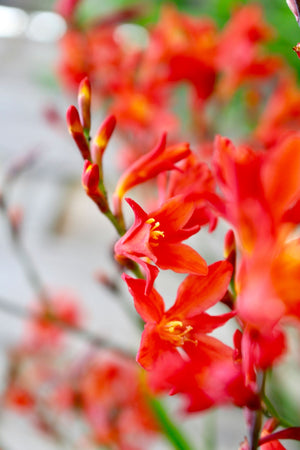
How to Use Crocosmia
Crocosmia offers versatility and can be utilized in various ways to enhance your garden and outdoor spaces. Here are some recommendations based on their characteristics:
Borders and Beds: Crocosmia’s tall, arching stems and vibrant flowers make them perfect for adding height and color to garden borders and flower beds. Plant them in clusters or drifts for a dramatic display of color and form.
Containers: Crocosmia can be grown in containers, making them a versatile choice for patios, balconies, or small gardens. Choose a large container with good drainage and place it in a sunny spot to enjoy the plants up close.
Cut Flower Arrangements: Crocosmia blooms make stunning additions to cut flower arrangements. Harvest the flowers when they are fully open and use them in bouquets, centerpieces, or floral displays to bring the beauty of the garden indoors. Their long-lasting flowers add a touch of elegance and vibrancy to any arrangement.
Mass Plantings: In larger landscapes, Crocosmia can be used in mass plantings to create a stunning visual impact. Their tall stems and bright flowers can fill large spaces with color and texture.
Mixed Plantings: Combine Crocosmia with other summer-blooming perennials, such as dahlias, daylilies, and echinacea, to create a lush, colorful garden. Their bold flowers and graceful stems will complement other plants beautifully.
Conclusion
Crocosmia is a captivating and versatile addition to any garden or outdoor space. With their vibrant flowers, arching stems, and relatively easy care, Crocosmia plants bring a touch of dynamic color and movement to your environment. Their adaptability to various growing conditions and ease of care make them a favorite among gardeners of all levels. By following proper planting and maintenance techniques, you can fully harness the potential of Crocosmia to enhance your garden, creating a lasting impact.
Whether you seek to create stunning flower displays, add visual interest to borders and beds, or enjoy their beauty in containers, Crocosmia can fulfill a variety of roles in your landscape design. Place them individually to highlight their unique blooms and arching stems, or combine different species and varieties for a dynamic and visually appealing display. Crocosmia’s resilience and adaptability also make them ideal for mass plantings and mixed gardens.
Beyond their ornamental value, Crocosmia plants contribute to the overall beauty and charm of your garden ecosystem. With their enduring beauty, versatility, and ecological significance, Crocosmia plants bring delight and natural allure to your outdoor environment, enriching your gardening experience and enhancing the overall beauty of your landscape.

